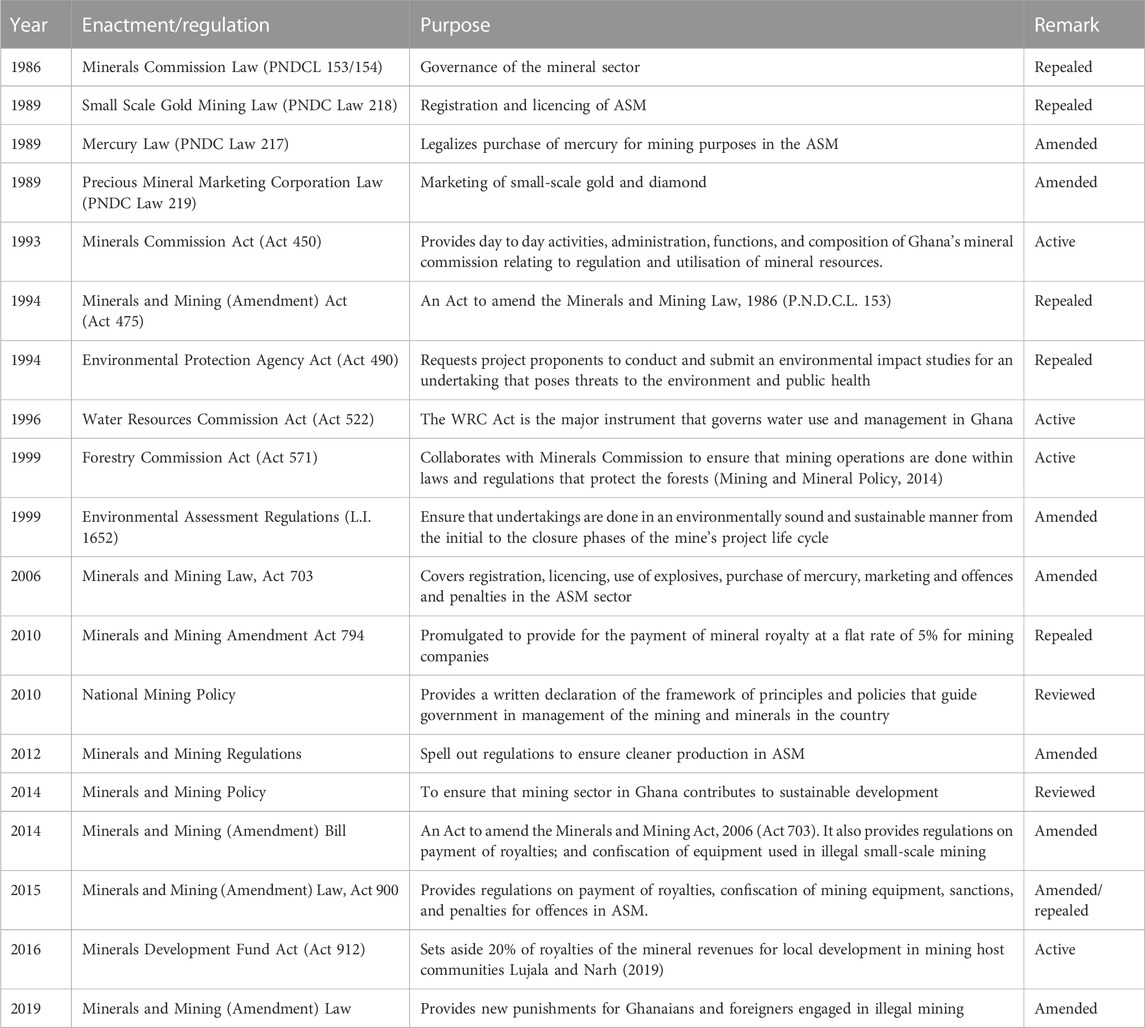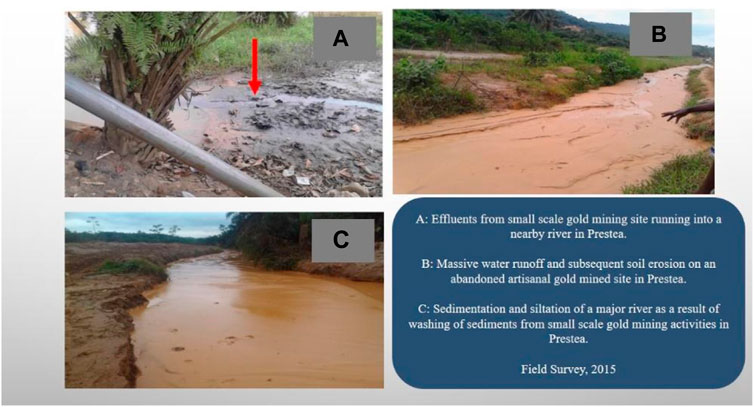- 1Council for Scientific and Industrial Research- Soil Research Institute, KwadasoKumasi, Ghana
- 2Technical Support Unit, Mercy Corps, Washington, DC, United States
- 3Antioch University, Keene, NH, United States
Introduction: Although artisanal gold mining has contributed to livelihoods in many rural communities across the world, it has destroyed and polluted several water bodies.
Methods: Using Prestea in the southwestern region of Ghana, this paper demonstrates how artisanal gold mining has culminated in the pollution of freshwater bodies and the ecosystem. A non-probabilistic purposive sampling technique was used for the selection of twelve artisanal gold mining communities. We used participant observation, in-depth interviews with stakeholders, a review of policy and legal documents, reports from media websites, and site visits to various artisanal gold mining sites. We observed that artisanal gold mining has destroyed major rivers, which used to serve as major sources of water supply for domestic and irrigation purposes. To achieve benign production, the Ghanaian government over the years has made efforts to formalize the operations of galamsey activities through six main routes: policy intervention, a complete ban on their activities, military strategy, national dialogue, alternative livelihood programs, and community mining. We assessed the sustainability of three of these measures (i.e., policy intervention, a complete ban on ASM, and the military strategy).
Results: We found that none of these approaches is sustainable, as the miners continue to defy the orders and military brutalities and return to mining sites to continue their operations.
Conclusion: Therefore, acknowledging ASM as a significant tool for reducing poverty and its pertinent contribution to the larger economy, providing tax exemptions and incentives to informal miners to boost their production, involving local mining communities and subaltern miners in mineral governance and decision-making, removing bureaucracies and lowering costs to make the registration of new ASM businesses easier, and strengthening the mine regulatory infrastructure are necessary to formalize the sector.
1 Introduction
Artisanal small-scale mining (ASM) is a traditional type of mining that occurs in over 80 countries around the world, involving 30 million people (Tuokuu et al., 2020). The sector generates revenues for governments (Owusu et al., 2019), reduces rural poverty (Ofosu et al., 2020), creates employment for an unskilled workforce (Jønsson & Fold, 2011), and produces metals that are used for technological advancements, such as in the production of computers, aircrafts, medical and agricultural equipment, and cell phones. Presently, ASM provides livelihoods to more than 150 million people globally and accounts for more than 20%–30% of gold production, 20% of diamond production, 26% of tantalum production, 25% of tin production, and 80% of sapphire production in the world (Fritz et al., 2017).
In Ghana, ASM has been practiced for over a century, accounted for nearly 40% of total gold produced in 2016, and generated about two billion United States dollars within the same year (Owusu, Bansah, and Mensah, 2019). In 2018, the ASM sector contributed 2.1 million ounces of gold, equivalent to 43.1% of the total gold production in the country. The sector accounts for 60% of Ghana’s mining labor force (Tuokuu et al., 2020). These benefits, however, have come with costs such as water pollution (Budianta et al., 2019), land degradation, destruction of productive agricultural lands (Mensah, et al., 2015), and the discharge of toxic elements such as Mercury into soils and water resources (Niane et al., 2019).
The Ghanaian government has tried to formalize mining operations through six main channels over the years in order to enhance environmental performance, address safety concerns, and increase the benefits of the sector: policy interventions, a complete ban on their operations, military strategy, national dialogue, alternative livelihood programs, and community mining. The security forces have often been stationed in unofficial mining regions to deter miners who are working there without a permit from the government. When security personnel are used for this reason, it frequently leads to casualties, brutality, the seizure of mining equipment, or the destruction of pricey mining equipment. Several academics have critiqued this strategy (e.g., Hilson, 2017; Bansah et al., 2018; Tuokuu et al., 2020). The miners typically return to the mining locations to resume their operations, despite the serious violations of their human rights and the casualties they suffer at the hands of the security forces. The Ghanaian Armed Forces, Ghana Police, Ghana Immigration Service, and the Forestry Service all contribute trained security personnel to the military task group. A military deployment is often supported by tactical strategies that have been well thought out as alternatives. However, Ghana’s military operations against illegal miners have typically been unplanned and characterized by ad hoc techniques lacking a detailed blueprint.
Several studies on ASM have been conducted (Hilson, 2017; Bansah et al., 2018; Tuokuu et al., 2020). For example, while Hilson et al. (2014) suggested that the problems within the sector are mainly due to informalities, Bansah et al. (2018) argued that inadequate ASM regulations and enforcement of existing enactments are largely responsible for the environmental problems associated with the sector. Although scattered pieces of these studies provide insights on the need to formalize the sector, a more consolidated single study on the degradation of the ecosystem and water resources and critiques of the various reforms taken by governments since 1980 to reform the artisanal gold mining sector are noticeably absent in current scholarly work. Our study seeks to bridge the above research gaps and propose strategies to formalize the ASM in Ghana. These include an appraisal of the regulatory instruments put in place by governments since 1980, the use of military strategies against the subaltern gold miners, the institution of a ban on the activities of ASM, and the setting up of inter-ministerial committees on illegal mining in 2017. Such a study is key to highlighting the gaps and to proposing sustainable strategies and mitigations to help improve the environmental performance within the artisanal gold mining sector. In addition, our study will help provide scholarly knowledge and a contribution to the current debate in Ghana and inform policy action in reforming the sector.
2 Conceptual clarification and artisanal mining policy reforms in Ghana
2.1 Artisanal mining enactments and regulations in Ghana since 1980
Since the 1980s, over thirty laws have been passed in Ghana in an effort to formalize or regulate the mining industry. The artisanal mining industry was regulated by eleven of these laws, but seven of them have since been repealed or changed (Table 1). The enforcement of the various laws is the responsibility of regulatory organizations including the Environmental Protection Agency, the Water Resources Commission, and the Forestry Commission. The regulations that govern artisanal and small-scale mining in the nation are briefly explained.
2.2 Military intervention: chasing artisanal miners with military brutalities
The government, over the years, used the services of the military, police, or joint security efforts to pursue informal or unregistered artisanal and small-scale miners (Figure 1). The military deployment mostly resulted in the arrest of miners, human rights abuses including relocation of miners, deportation of foreign nationals, wounds and gunshots to miners, confiscation of mining equipment, and burning and seizure of mining equipment such as excavators at the mine sites. However, these actions seem not to be enough to stop the subaltern miners from returning to the mine sites and engaging in their activities. Four military interventions or operations have been taken against artisanal mining in Ghana since 2006. Previously, the police used to chase the miners from their mine sites, and many were arraigned before court. Human rights abuses, casualties and brutalities associated with the regimes are reported here. The regimes have been the following: Operation Fight Illegal Mining-2006; Operation Flush out Galamsey in 2013; Operation Vanguard in 2017; and Operation Halt in 2021.
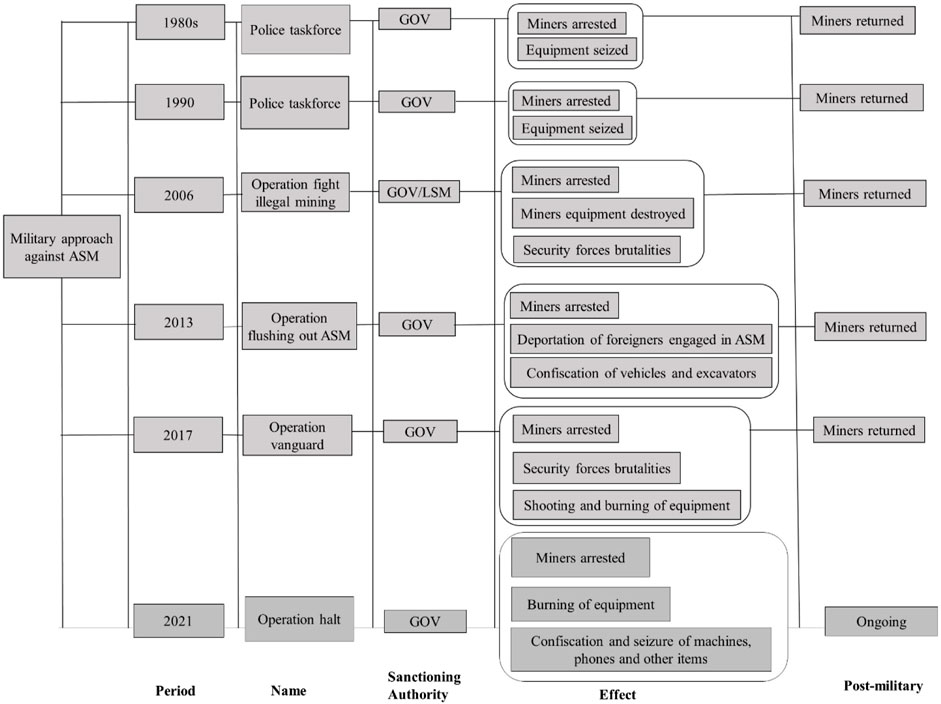
FIGURE 1. Conceptual framework showing the use of military to chase informal, unregistered artisanal miners in Ghana from 1980–2021.
2.2.1 Arrests and deportation of foreign nationals
The use of military intervention against artisanal miners has resulted in the total arrests of 1502 (11% of abuses reported) Ghanaians and 1948 foreign nationals, representing 14% of the total abuses reported between 2006 and 2022 (Figure 2). In the 1980s, the government enlisted personnel from the Ghana Police Service to remove informal artisanal miners from the country’s forests, waters, and soils. The taskforce had arrested and prosecuted more than 200 miners by the time it was disbanded.
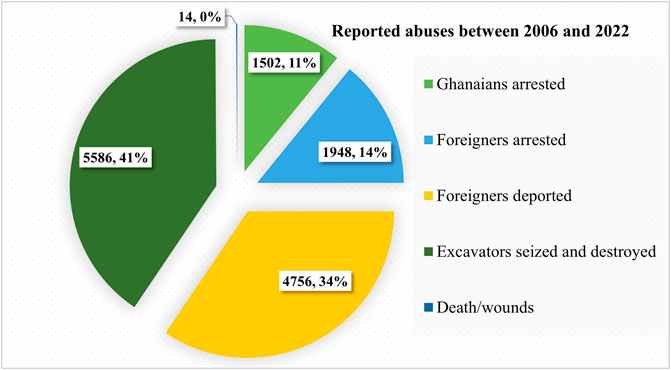
FIGURE 2. Total number of casualties meted out against artisanal gold miners by the use of the military task force between 2006 and 2022.
“Operation Flush Out galamsey” was formed in 2013 to remove both Ghanaians and foreigners who engaged in illegal mining in the country. The operation led to the arrest of more than 500 artisanal miners and the deportation of over four thousand Chinese and other foreign nationals1 who engaged in informal artisanal mining (see Figures 3, 4, 5). This proportion also included the arrest of more than 740 Chinese nationals among the deportees in 2013 (see Figure 5). The Chinese continue to dominate the number of foreign nationals engaged in artisanal gold mining in Ghana and hence they dominate those that are deported and arrested in a crackdown against galamsey in Ghana.
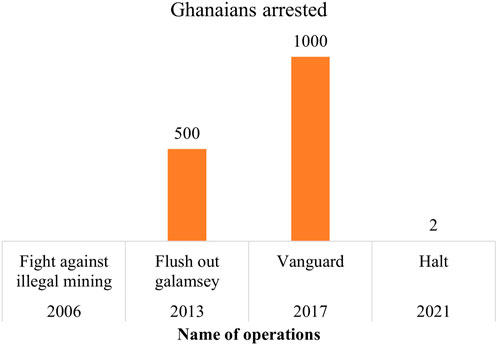
FIGURE 3. Number of Ghanaian nationals engaged in artisanal mining and arrested by the various military regimes between 2006 and 2022.
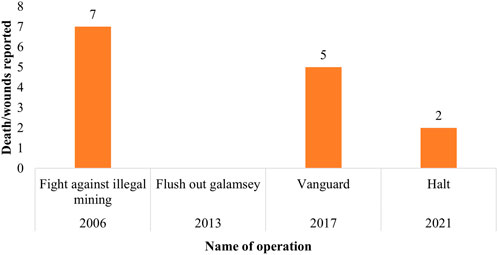
FIGURE 4. Number of wounds and deaths caused to artisanal gold miners reportedly by the various military operations launched by governments of Ghana between 2006 and 2022.
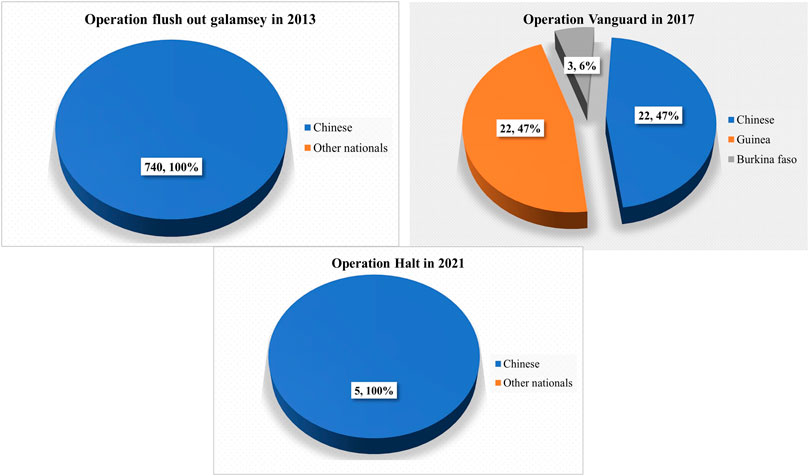
FIGURE 5. Number of Chinese and other foreign nationals who were arrested during the crackdown against galamsey in Ghana between 2006 and 2022.
Additionally, Operation Vanguard in 2017 ordered the arrest of 1000 Ghanaians. By the time Operation Vanguard was disbanded in early 2021, their operations had led to the arrest of over 1,000 informal artisanal miners including foreign nationals (e.g., miners from neighboring countries like Burkina Faso and Togo). Like the predecessor, Operation Vanguard also led to the arrest of 47 foreign nationals-including 22 Chinese, 22 Guineans and 3 nationals from Burkina Faso (Figures 5, 6). The Chinese and Guinea foreign nationals each represented 47% among the nationals arrested that year and Burkinabe’s accounted for 6% of foreigners arrested that year.
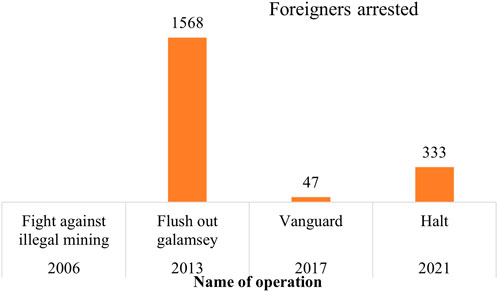
FIGURE 6. Number of foreign artisanal miners arrested by the various military regimes between 2006 and 2022 in controlling the artisanal small-scale mining (galamsey).
In April 2021, a similar strategic operation was launched to manage the sector. The president of Ghana at the time issued a directive to the Ghana Armed Forces to remove all the logistics used in illegal mining on water bodies. The taskforce was made up of 200 military officers and were deployed to the western and central regions to halt the operations of illegal miners. The operation this time was dubbed, “Operation Halt,” and consisted of personnel drawn from the Ghana Army, the Navy, and the Airforce, with support from the Ghana Police Service, Ghana Immigration, and Forestry Commission.
The government hinted that Operation Halt was to perform a “surgical operation” to flush out all illegal miners, including foreigners engaged in mining in the country’s forests and rivers. This operation led to the arrest of Chinese nationals, destruction of excavators and “Changfa” machines, and the impoundment of other tools such as fuel pumps and electric power generators. By July 2021, operation halt had arrested five Chinese nationals (see Figures 5, 6). It is further reported that between 2017 and 2019, the military task force put in place by Operation Vanguard has arrested over 2,200 illegal miners, including foreign nationals (Koomson, 2019)2.
2.2.2 Machines seized, confiscated, and destroyed
Seizure, confiscation and destruction by the military task force of machines mostly excavators belonging to the miners remain the highest among the reported human abuses and casualties. Between 2006 and 2022, approximately 5,586 (47% of reported casualties) excavators have been either seized, confiscated, or destroyed at the various illegal mining sites (see Figure 2). Specifically, the operation Flush Out seized, and destroyed 174 machines in 2013, Operation Vanguard destroyed 4,820 in 2017 and Operation Halt destroyed 592 machines by July 2021 (see Figure 7).
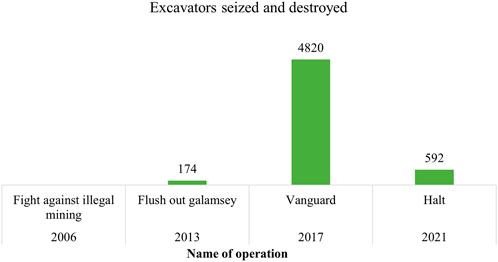
FIGURE 7. Number of excavators seized/and or destroyed by the various military regimes between 2006 and 2022 in controlling artisanal small-scale mining (galamsey).
2.2.3 Wounds and deaths reported
The military task force and deployment has led to a total of 12 reported deaths and wounds among the informal miners between 2006 and 2022, representing the lowest figure among reported abuses and brutalities (Figures 2, 4). Operation Fight against Illegal Mining orchestrated by the Ghanaian government at the time led to the highest number of both wounds and deaths of 7 people, followed by operation vanguard which led to reported deaths and wounds of 5 people. The 7 people who sustained wounds and gunshots by the military taskforce and the police were in Prestea during a demonstration by the citizens (Hilson et al., 2007). We could not record any fatalities in the regimes of Operation Flushing out Galamsey in 2013 and Operation Halt in 2021.
2.2.4 Reported human right abuses including relocation and shootings
On 10 October 2006, army officers began their well-coordinated sweep in Prestea, in the country’s Western Region, where they suspended all unlicensed workings, destroyed a significant amount of mine equipment, and made numerous arrests. They went on to Obuasi (Ashanti Region), then eastward to Noyem and Ntronang (Eastern Region), where they arrived unannounced on December 6. Following the forced closure of galamsey pits in the Ashanti Region, the Minister of the Western Region called for all illegal miners operating within the Prestea locality to cease operations. Subsequently, the National Security Council dispatched police and army personnel to target artisanal miners. This military approach, like its predecessor, resulted in the arrest and shooting of miners, as well as the destruction of equipment. These accounts are reported in detail in Hilson et al. (2007).
As an example, the Ministry of Mines “relocated 1,000 artisanal mining operators from Prestea to Japa, Adjumadium, and Oguakrom as part of the measures to control and monitor the activities of small-scale miners.” Violence, violations of human rights, and the destruction of mining equipment all occurred during Operation Vanguard’s operations (Hilson, 2017; Bansah, 2019). The destruction of more than 2,000 Chinese-made “Chang Fa” machines in Atwima Mponua, Amansie West, Amansie East, Konongo, and other districts in the Ashanti Region, the alleged shooting and killing of a galamsey operator in Wawasi, also in the Ashanti Region, and hundreds of arrests are just a few of the human right abuses mentioned (Hilson, 2017).
2.3 Ban on ASM and inter-ministerial committee on illegal mining (IMCIM) in 2017
In addition to Operation Vanguard, a ten-person Inter-Ministerial Committee on Illegal Mining (IMCIM) was established in 2017 to oversee the ban and ensure that the ASM sector was formalized. The committee was composed of representatives from the following ministries: interior, defense, information, water and sanitation, lands and natural resources, monitoring and evaluation, local government and rural development, chieftaincy and religious affairs, environment, science, technology, and innovation. According to Bansah (2019), the committee was tasked with carrying out seven main duties. The incumbent government, led by President Akufo-Addo, took a number of drastic actions aimed at stopping the so-called menace. As previously stated, it implemented a general ban on artisanal and small-scale mining operations on 1 April 2017 for a period of 6 months, and suspended the issuance of new licenses for small-scale mining for a year. It also created an inter-ministerial committee on illegal mining (IMCIM), whose job it is to address illegal mining (Hilson, 2017; Bansah, 2019; Tuokuu et al., 2020).
3 Materials and methods
3.1 Study context
This section of the study was conducted in 12 mining communities in Ghana’s western Prestea Huni-Valley District (Figure 8). Prestea may be found at coordinates 5.43274 and 2.14284. The study area has roughly 35,760 residents, making it Ghana’s 46th most populous town. Farming, small-scale trading, and gold mining are the main socioeconomic or subsistence activities in the region (large scale and small scale). The majority of people work in petty commerce, which involves selling items including food, stationery, candy, and apparel. In the Prestea Huni-Valley District, the private informal sector employs 89.1% of the workforce, followed by the private formal sector, which has a 7.5% employment rate (Ghana Statistical Service, 2014).
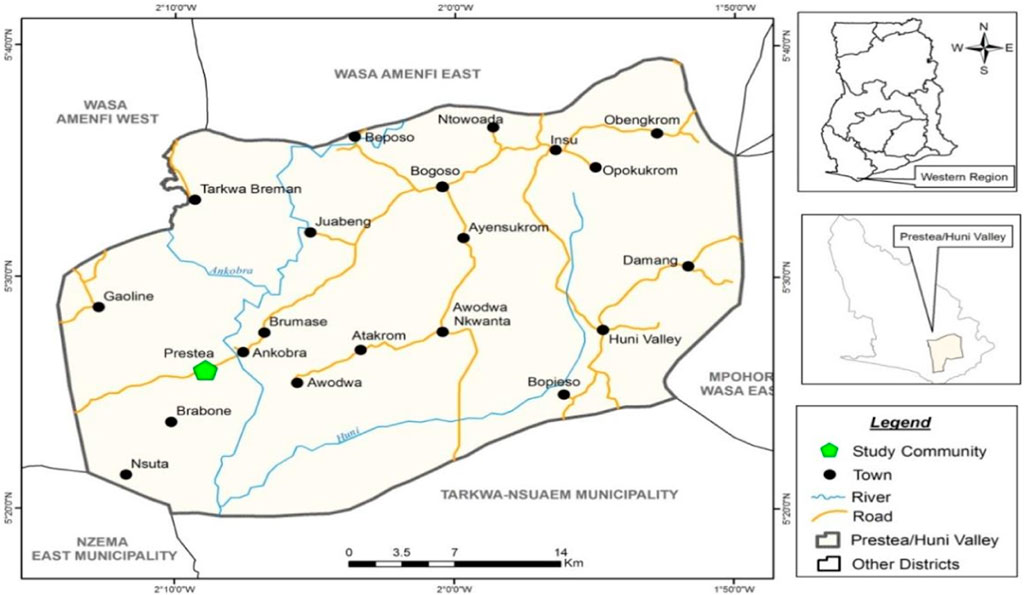
FIGURE 8. Map of the Prestea Huni-Valley District showing the study community, Prestea. Source: Cartography Unit, Department of Geography and Regional Planning, University of Cape Coast, Ghana (2015).
Prestea is located 59 m above sea level on average. It is located on the west bank of the Ankobra River, about 60 miles (100 km) northwest of Cape Coast, and about 50 km north of the Atlantic Ocean’s coast. In Ghana’s rain forest region, the Prestea Huni-Valley District has a humid subtropical climate. The two rainy seasons last from March to July for the long rains and from September to November for the short rains (Ghana Statistical Service, 2014). The district receives a lot of rain; the average annual rainfall is 187.83 mm. All year long, there are high temperatures with notable daily and seasonal changes. The average annual temperature is between 26 and 30°C. In the wet season, humidity ranges from 75% to 80%, and in the dry season, it ranges from 70% to 80% (Ghana Statistical Service, 2014).
3.2 Sampling design and data collection
Both primary and secondary data sources were used in this investigation. An entirely qualitative field survey research approach was used to gather primary data, with the majority of the data being gathered using qualitative methods. A variety of small-scale gold mining locations in Prestea were subjected to environmental evaluations, in-depth interviews, and participant observation as effective methods for gathering primary data. Data for this section of the study were gathered between April and October of 2015; but additional data on the policy interventions, military approach and the ban on the activities of ASM were collected between 2020 and 2022.
For the purpose of selecting the 12 villages to be surveyed, a non-probabilistic purposive sampling technique was used. Random informal miners were interviewed at their mining locations and in the communities after these communities were chosen because to the preponderance of galamsey operations there. The secondary data used in this study came from a critical assessment of the literature on the effects of gold mining on water resources, the effects of artisanal and small-scale gold mining in Ghana, and a review of pertinent laws and regulations in effect to control the industry. The standard international best practices of environmental protection were also examined in international treaties, other agreements, and publications. Additionally, secondary data included desktop analyses of legislative actions, military interventions, and compilations of information on abuses and brutalities related to the intervention from media house websites on the internet, including Ghanaweb.com, ModernGhana.com, Citinewsroom.com, Myjoyonline.com, Aljazeera, and BBC.
3.3 Data analysis
With the consent of participants, the qualitative interviews were tape-recorded with each section lasting between 45 min and an hour. The recorded data was subsequently transcribed and analyzed thematically. We did a careful reading of the transcripts to be familiar with the data from the interviews (Tuokuu et al., 2020). We also used pseudonyms to protect the confidentiality of the participants. The recorded tapes together with the transcripts were read repeatedly to ensure consistency and also to ensure that we do not misrepresent any participant. It also ensured that the major themes identified in the study were consistent with the objectives of the study. Further readings were done to ensure the validity and reliability of the data and to establish the themes that emerged from the data. We also used direct quotations where necessary to support the themes.
4 Research findings
This section presents the findings of the study with a view to drawing logical conclusions from the findings. The problems of water resource degradation resulting from galamsey activities in Prestea are discussed based on the following major themes that emerged from the study:
i. Mercury pollution;
ii. Sedimentation/siltation/turbidity;
iii. Excessive erosion due to vegetation removal;
iv. Un-reclaimed and abandoned mined fields; and
v. Implications of the artisanal gold mining activities
4.1 Mercury pollution
At numerous galamsey mining locations, it was seen during the field survey that Mercury was handled improperly. They use metallic Mercury in their mining technique to separate the fine gold from the ore pulp. Without applying the proper environmental safeguards, miners were seen mixing the gold-contaminated sediments with Mercury outside. Usually, the Mercury was stirred into the sediment by hand without the use of gloves. During the process, this contaminated water escapes into the environment and contaminates nearby rivers, soils, and plants and vegetation (Figure 9A). Following this procedure, it is customary to transport the gold amalgam to the refinery and burn it there over an open flame. There are no safeguards in place during this process to protect the environment or the miner. According to Rajaee et al. (2015)’s findings, Mercury is used in artisanal gold mining without any kind of appropriate controls to lessen chemical releases into the environment.
Due to its high toxicity, persistence in the environment, and potential for bioaccumulation across trophic chains, Mercury (Hg) poisoning of water is a serious problem (Rodrigues et al., 2013). According to Kitula (2006), metabolic processes can convert metallic Mercury released into the environment (air, water, tailings) into methylmercury (MeHg), which is easily accessible and may be found at high concentrations in higher levels of the food chain, especially in aquatic systems (this phenomenon is called biomagnification). In this situation, those who depend on fish may be especially vulnerable to exposure to methylmercury at dangerously high levels (Kitula, 2006). High levels of Mercury have been found in the blood (102 g/L) and urine (34.5 g/L) of residents and mine employees in these mining communities who often rely on the Ankobra river basin for their livelihood3. These values in the blood samples are in some instances higher than the 50 g/L WHO threshold.
Mercury is in the top 10 of chemicals of major public health concern according to the World Health Organization. By enhancing the reduction of Mercury pollution, the Convention protects the environment and the lives of millions of people around the world. The Minamata Convention recognizes the health impacts of Mercury on the environment and humans.4 The Minamata Convention on Mercury is a global treaty to protect human health and the environment from the adverse effects of Mercury. Article 7 of the Minamata Convention solely blames out artisanal and small-scale mining sector as the major contributor to Mercury pollution and thus nations should put in efforts and actions to minimize Mercury use and its effects.
Since it came into effect on 16 August 2017, Parties have cooperated to control the supply and trade of Mercury, reduce Mercury use, emission, and release, increase public awareness, and create the institutional capacity needed to eliminate the Mercury effect and impact. Ghana ratified this agreement on 23 March 2017. The Ghanaian president officially launched 100 Mercury-Free Gold Processing Equipment called the Gold Katcha, on the 6 June 2022. As the name implies, it is a piece of machinery that extracts gold from ore without using Mercury. Small-scale miners get much more gold from this equipment than they would have from the conventional method of using Mercury because it can recover over 90% of the gold from the ore5. Therefore, the mercury-free gold mining technology is a very significant step in the direction of achieving the Minamata Convention.
4.2 Sedimentation, turbidity and siltation
In Prestea, artisanal gold mining activities primarily result in sedimentation, turbidity, and siltation of the water resources through the generation of waste, storage of mine wastes, washing of gold-infested sediments without any precautions, and construction of mine pits without backfilling. Previously, when a significant malfunction of the water pumps in the area occurred, a former underground mining engineer who was interviewed during the field study recalled how he used to physically walk under a bridge over the river (Figure 10C) for plumbing repairs. He used to assist in pumping river water to supply the Prestea settlements. He said this:
We used to pump water from this spot to the neighborhood since the water was so clean. This river’s source were rocks that traveled all the way from the town of “Obouho.” Our water sources began to deteriorate when these artisanal gold mining operations (also known as “galamsey”) began. Their operations—particularly those from “Changfa,” which typically take place in the river body—wash sediments into river bodies, which eventually cause them to fill up and dry out the rivers. A river and a bridge were present here. For plumbing tasks, I personally used to cross the bridge by foot to the other side. It was quite clean. We used to pump water from this river to serve the Goldfields International Schools and the bungalows. (R1)
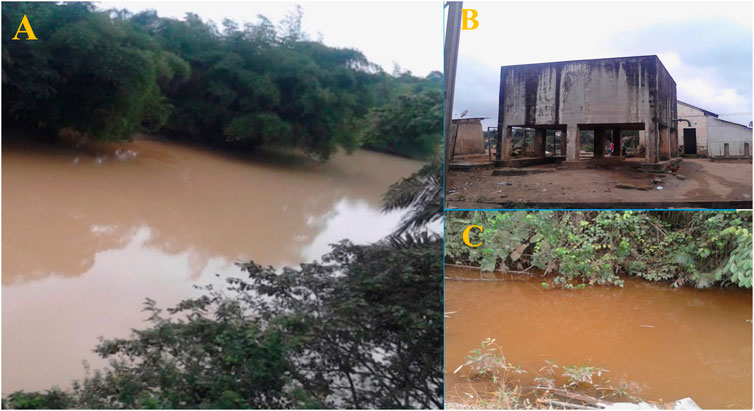
FIGURE 10. Major rivers in Prestea highly polluted and idle water tank constructed to store water for the township. (A) Highly polluted river Ankobra due to artisanal gold mining activities in Prestea. (B) Idle community water storage tank at in Prestea, due to shortage of water to pump into the tank. (C) Highly polluted river Asasree due to artisanal gold mining activities in Prestea.
During an interview, another neighbor mentioned how clean the river was and how he used to occasionally wade in to catch fish and other aquatic life for his family’s consumption.
“This river was really clean,” he claimed, “and I personally used to get in from time to time to capture some fish for home consumption after I got off work.” (R2).
A different local claimed:
“Right here was a river; they used to pump this water for us to drink. It was quite tidy. This is the water we used to carry with us whenever we went to the farm and drink it again when we got back. When we were kids, we even went swimming in it. (R3).
During the course of this study, it was observed that numerous small-scale gold mining sites have been producing enormous amounts of mine waste and piling it up without taking the proper environmental safety precautions. These operations move materials into river bodies, especially during periods of intense storms and rainfall, which causes sedimentation, siltation, and turbidity of the rivers, in line with the finding made by Kitula (2006) in small-scale gold mining sites in Tanzania. Additionally, these wastes contain hazardous substances and minerals that may react with water to create contaminated fluids that might harm local communities’ soils, rivers, and huge bodies of water. Additionally, the process of stockpiling in mounds has an impact on the biological, chemical, and physical characteristics of the soil. Stockpiling can cause a decline in soil aerobic and anaerobic microbes.
4.3 Vegetation removal and excessive erosion
We found that a significant percentage of the Prestea-Huni Valley’s terrain is now barren due to artisanal gold mining. Large tracts of land have lost their vegetation cover due to ASM operations in a number of locations. The results can be seen in the area as large gullies, excessive runoff, severe erosion, decreased soil infiltration, decreased groundwater recharge, and subsequently loss of land productivity. Many of Prestea’s artisanal gold mining locations exhibit these consequences. The upshot was the destruction of the lush greenery, wildlife, farmlands, historic monuments, and water bodies that surrounded the bulk of the local communities.
According to Hilson (2002), small-scale gold mining has led to widespread deforestation and large-scale clearing of surface vegetation in Ghana. ASM activities have cleared vegetation and topsoil to make way for surface mining, which frequently results in the alteration of microbial communities, loss of soil fertility and productivity, and inevitably the permanent loss of farmland; supported by Schueler et al. (2011), who evaluated the effects of small-scale mining on lands in the Western region of Ghana.
4.4 Un-reclaimed and abandoned mined fields
The issue of numerous abandoned and unreclaim mined pits and fields is one of the primary environmental impacts brought on by small-scale gold mining activities. Usually, these artisanal gold miners leave fields that have been worked on without reclaiming them. Several abandoned lands, wastelands, and pits, including stockpiles, mined spoils, dugout underground mined pits, and tailing sites, were found left abandoned without protection in the area throughout the survey. For instance, the artisanal gold miners’ underground mining pits had been exposed and abandoned in previously exploited locations. These bare abandoned mine spoils, pits, wastelands, and tailings contribute to water runoff that eutrophicates neighboring water bodies and destroys agriculture and plant biodiversity in addition to producing siltation and sedimentation. Additionally, the process obstructs waterways and other drainage systems, which eventually causes flooding and droughts. One person admitted during an interview that this neighborhood floods during heavy rainstorms.
As this water running on the soil surface does not penetrate into the soil to contribute to groundwater recharge, there is also the prospect of a significant impact of groundwater loss in the area. The area is vulnerable to impending water scarcity in the long run due to the large amount of water run-off from these naked, unreclaim, and abandoned fields that run off the land surface freely without any procedures and structures put in place to harvest these water sources. According to Aryee et al. (2003), productive arable lands are left naked and abandoned due to gold mining operations without any type of protection increase runoff, which leads to river water being murky. As a result, Ghana has been identified as a nation that could experience water stress by 2025 (Deshpande and Gupta, 2004). Situations of this nature, if unattended to, could exacerbate the catastrophe.
Additionally, the water that has been kept in these abandoned mined areas and pits seeps or infiltrates into the soil, contaminating any groundwater that may be there. Although a groundwater quality assessment was not conducted for this study, Koratsi (2004) found that heavy metal concentrations in numerous Prestea groundwater sources surpassed WHO drinking water quality standards. According to Asare-Donkor and Adimado (2013), artisanal gold mining practices are known to seriously harm human health and pollute groundwater in the Prestea gold mining regions.
4.5 Implications of the artisanal gold mining activities in prestea
Water resources and the ecology in general have suffered significantly as a result of the artisanal gold mining operations in Prestea, Ghana. The expense of treatment, for instance, has increased as a result of the area’s primary surface water bodies being both extensively degraded and heavily contaminated. The main rivers of Prestea have also been depleted as a result of this predicament. Field research and interviews with several Prestea locals revealed that major rivers that once provided the majority of the community’s water supply have dried up and are severely polluted as a result of sediments from small-scale, illegal gold mining activities being washed into these rivers. These rivers include the river “Asasree” and the river “Ankobra” (Figures 10A, C). One respondent revealed during an interview:
Residents of Prestea’s several towns travel to these rivers to collect water during times of water scarcity with their Jeri cans, buckets, and tanks piled onto vehicles and pickups. When they were close from schools, students would directly swim in them and drink from them. These rivers were once used by farmers to irrigate their agricultural land. Once more, farmers fill their bottles with this water before heading to the farm and use them to drink when they return. On their way to and from work, pedestrians and bystanders used to quench their thirst by drinking from this river. Additionally, both adults and children used to enter these rivers to swim and catch fish for their own consumption. (R4).
Similar conversations with some locals revealed how their water sources have been harmed by these artisanal gold mining operations. They stated that in times of water constraint, engineers would pump water from the Asasree river to supply Prestea settlements like “Dagaate Compound.” A water storage tank was constructed to hold water from the river “Asasree” for distribution to residents of one hamlet known as “Dagaate Compound,” as seen in Figure 10B. Due to water shortage brought on by river pollution, this water storage tank has been sitting empty for a while and is no longer functional. One local said the following:
“I was one of the mining engineers in charge of the pumps. In order to fill that tank at “Dagaate Compound” and other towns, we used to install pumps to pump water from the Asasree River at Asoampa. You see, water despises dirt, so when the Galamsey people arrived, they began washing sediments into the river. In this hamlet, water is initially not in low supply. As soon as the galamsey began, an issue with this water pollution began” (R5).
Residents of Prestea have turned to groundwater as an alternative source of water as a result of the aforementioned issues. During the field survey, interviews with some Prestea locals indicated that they pay astronomical sums of money to obtain and clean groundwater for domestic uses including drinking, cooking, washing, and bathing. These have detrimental effects on the way of life and economics of the inhabitants of Prestea. These findings concur with those of Asare-Donkor and Adimado (2013), who found that the large towns of Prestea and Bogoso exclusively use groundwater for household purposes (primarily from hand-dug wells and boreholes). Kortatsi (2004) also noted that Prestea is fast developing more hand-dug wells and boreholes to meet the demand for potable water. During the field survey, an interview with a Prestea respondent revealed:
“We have to drill up to 80 m below ground merely to get clean water. We spend up to 12,000 Ghana Cedis ($3,500) on digging, laying the pipes to access the groundwater, and constructing the storage tanks. (R6).
5 Discussion and emerging issues
This study looked at the degree of water resource damage brought on by artisanal gold mining, which predominates in Prestea, western Ghana. We use the SWOT analysis to look at the Opportunities, Threats, Weaknesses, and Strengths of artisanal and small-scale gold mining operations in southwest Ghana.
Small-scale surface gold mining’s strength or advantage is that it has significantly improved the socioeconomic wellbeing and means of subsistence of mining communities. The cost-effective approach, minimal and modest expenditures in capital, and low technical skill requirements have indirectly helped the mining towns by luring numerous artisans into the sector as an alternative source of employment.
The drawbacks and/or dangers of these mining operations, however, are that they have seriously harmed the water resources in the vicinity of the mines. The area’s small-scale mining operations have led to numerous rivers and surface water bodies becoming severely polluted and degraded. In order to access, clean, and store groundwater for residential and other uses, as well as to treat the polluted river water, people in these mining areas incur significant costs. This endangers their economy and way of life. The miners’ health is also at risk when they process gold with Mercury without taking any safety precautions because they handle the Mercury with their bare hands. Another flaw is the relatively informal nature of small-scale mining, which has made it more difficult for the government to regulate through current laws and policies. This is because there are currently very few small-scale artisanal mining operations that are registered, making it very challenging to monitor their operations and enforce mining laws. Last but not least, insufficient research and coordination between pertinent institutions and sectors create barriers to sharing and exchanging the information required to address issues with water resource degradation brought on by small-scale gold mining activities (Tuokuu et al., 2018).
But there are lots of chances to watch over, develop, and advance the small-scale mining industry. It is necessary to streamline the registration and legalization procedures for the region’s numerous illegal small-scale mining operations (Tuokuu et al., 2020). This calls for a formalization procedure that will greatly benefit the government by bringing in more money. Since unlicensed artisanal miners are required to make several payments, including bribes to chiefs, landowners, and the police, getting formal licenses is time-consuming and expensive. For instance, Hilson & Hilson (2017) stated that applicants for ASM licenses must go through a number of formalities, pay a number of expensive fees, and occasionally travel great distances to meet with officials. According to Mensah et al. (2015), the difficult, drawn-out, expensive, bureaucratic, and irritating process of establishing an unlicensed mine may deter unauthorized small-scale miners from registering and applying for permits. As a result, such circumstances may lead to a disdain for all environmental laws and standards, opposition to military task forces, authorities, and the ban on ASM, leads to an increase in irresponsible mining activities, and a resulting degradation of the environment. Thus, it is argued that governments could make the ASM sector more formal by streamlining the licensing process for ASM operators, lowering permit costs, strengthening the devolution of registration offices at district capitals, and involving District Chief Executives (DCEs) and local assembly members in the management and governance of ASM issues (Hilson and Hilson, 2017).
Additionally, the process necessitates aggressive and targeted education and awareness campaigns to inform mining communities of the significance of registration and the acquisition of mining licenses, as well as the requirement for a clean and healthy environment. As part of a comprehensive strategy, this is combined with the creation of pertinent, responsive policies and institutional reforms that also address the driving forces behind the economic incentives in the region’s small-scale gold mining sector. A significant opportunity exists to stop further landscape degradation and finally put these lands back to work by reclaiming and rehabilitating abandoned mining pits. Mined pits that are left unfilled or exposed make the land unusable for other uses and pose a risk to both people and animals.
5.1 Sustainability of the ban on artisanal gold mining in 2017
The military strategy and ban in many gold mining communities exacerbated poverty, caused hardships in mining communities, and resulted in the loss of jobs and livelihoods for the small-scale miners and their families (Tuokuu et al., 2020). According to Zolnikov (2020), it also had an impact on the livelihoods of women who relied on the industry to maintain their families. This strategy also disrupted petty trading, farming, and other economic and commercial activities in many gold mining communities (Eduful et al., 2020), widened rural-urban migration, decreased the sector’s contribution to overall gold production (Owusu et al., 2019), and impacted gold mining revenues (Owusu et al., 2019). According to Tuokuu et al. (2020), the prohibition on ASM operations caused the local economy to collapse, drove more rural households into poverty, increased insecurity in mining areas, and weakened crucial stakeholder buy-in and support for restructuring the ASM sector. The ban on ASM’s activities may also have an impact on the percentage of school dropouts. This occurs as a result of parents losing income that would otherwise allow them to send their kids to school (e.g., Geenen, 2012; Tuokuu et al., 2020; Zolnikov, 2020).
The taskforce and IMCIM members’ politics, corruption, and bribery contributed significantly to the military intervention’s failure to address the so-called threat of artisanal mining. According to Crawford and Botchwey (2017), widespread state corruption serves as the foundation for the inability of various state authorities to uphold the law. Crawford and Botchwey (2017) observed that the failure of the use of the military approach in tackling and controlling the informality of the ASM business is largely attributable to corruption by numerous government officials, ranging from local government level to high-ranking central government personnel, including ministers of state. According to Gamu et al. (2015), corruption impedes the effective enforcement of the law, delays development initiatives, and as a result, widens poverty and inequalities in countries with abundant mineral resources.
As suggested by Hilson & Maconachie (2020), the task forces and committees established by the government were made up of dishonest public men lacking in integrity who looked for rent-seeking opportunities and instead acted more like private citizens who pursued their own personal gains at the expense of the state. Crawford and Botchwey (2017) made the following claim regarding this matter: “Those in public positions, including traditional authorities, have become increasingly oriented to pursuing private wealth accumulation rather than public service in a manner that undermines any notion of state effectiveness.” This was further demonstrated in an exposé on “galamsey fraud” by Ghanaian investigative journalist Anas Aremeyaw Anas6. The IMCIM secretary and other security personnel in charge of enforcing the prohibition on ASM were exposed in the video documentary as they accepted payments to permit illegal miners to operate. The consequences included an increase in the informal mining artisans’ operations, additional landscape deterioration, the loss of agricultural areas, water contamination, and ecosystem damage.
Our contention is supported by some earlier studies. For instance, Bansah (2019) reported that artisanal gold miners had complained about bribery and corruption among the personnel in charge of overseeing the industry. The artists admitted to paying bribes to officials, according to his findings, so that they could work without a license. The anti-illegal mining taskforce’s operations were influenced by “powerful” illegal ASM operators who had the support of politicians and traditional leaders, according to Eduful et al. (2020). They did this by giving them bribes. Crawford and Botchwey (2017) also stated that because those in positions of authority (such as public officials, politicians, and chiefs) provided protection in exchange for their personal gains, foreign miners—particularly those from China—operated illegally with impunity.
The failure to stop the galamsey “menace” can be attributed to a number of factors/reasons, including misplaced priorities, ambiguities, duplications, and conflicts of interest regarding functions, roles, and responsibilities of the members of the IMCIM. Members of political parties and government officials made up the majority of the committee’s selection and membership. Furthermore, there was no specific or legislative instrument supporting the creation of the committee. The oversight regulatory organizations, including the Environmental Protection Agency, the Water Resources Commission, and the Mineral Commission, already carried out all of the duties and responsibilities outlined for the IMCIM. Such command-and-control committees and strategies are ad hoc because they do not effectively consult and involve affected communities, are short-lived and impromptu, are unplanned, are not long-term sustainable, and do not address the underlying causes of the real problems associated with informal ASM. Other studies have supported and reiterated this argument (e.g., Geenen, 2012; Owusu et al., 2019).
In an interview, Dr. Tony Aubynn, the former head of Ghana’s Minerals Commission, he called for the dissolution of the IMCIM and argued in favor of fortifying the regulatory organizations mandated to take the lead in combating the “menace” of illegal mining7. The Ghanaian government was urged in a report published on MyJoyOnline.com, a major news source in Ghana, to reconstitute the mining committee and remove board members who are affiliated with a particular party. In the News Analysis Program, veteran journalist Abdul Malik Kweku Baako expressed the following opinion:
When you have a President, who dedicates and commits himself to that campaign and yet he is hugely challenged in terms of implementation, I will say to the party elements, ‘get them out quickly’.” “If there is a continuous political party involvement in any campaign to fight galamsey, it is not going to work7.
5.2 Sustainability of the military action in tackling informal artisanal mining-will the artisanal miners return or not?
These military operations have so far led to the deportation of Chinese and other nationalities engaged in artisanal gold mining in the nation as well as the arrest of foreign and domestic gold miners from Ghana. Military task teams have further seized and/or destroyed mining machinery (such as excavators, drilling machines, pumps, dredging plants, etc.) believed to be used in artisanal mining, leading to human rights violations and miner deaths. Despite taking these steps, miners continued to work in the minefields (see Figure 1), which frequently led to an increase in artisanal mining and significant environmental damage in the form of water contamination, forest destruction, and farmland depletion.
Because the country’s sole water treatment and supply agency claimed several years after the attempt that the activities of the informal miners had significantly increased the cost of treating river water for supply, it appears that the military strategy worsened the environmental pollution issues related to artisanal mining. Along with severe forest damage and the depletion of farmlands, turbidity of rivers caused by informal mining has gained prominence. In certain cases, residues of harmful compounds generated during mining were discovered in cocoa beans, urine, and blood samples taken from people who drank the waters that had been contaminated by mining (Kwaansa-Ansah et al., 2019; Ovadje et al., 2021).
Military strategy in the management of natural resources is frequently seen as a top-down, central management strategy where decisions are made without the active participation of those who will be impacted by them. Modern natural resource management practices require active community involvement in environmental decision-making, which is also the cornerstone of responsible and democratic environmental governance (Mensah et al., 2015). Military tactics used by central management only serve to coerce the artisans and prevent them from exercising their democratic rights and making meaningful contributions to responsible mining and environmental conservation. It should be noted that the government has made some efforts to ensure the decentralization of the registration process for ASM by setting up district mining offices of the Minerals Commission and lowering the cost of obtaining a small-scale mining license, as mentioned in the Minerals and Mining (2014). Despite these steps, miners continue to report instances of frustrating, expensive, time-consuming, bureaucratic processes while registering ASM firms, and other academics have also highlighted these incidents (e.g., Hilson and Hilson, 2017). Furthermore, without devolving administrative responsibilities to rural areas and the primary hubs of the nation’s gold production, too much of Ghana’s economic and political administration remains concentrated in the nation’s capital, Accra, and key regional capitals. Disregard for environmental laws and the unsustainable nature of military actions are the related consequences. The majority of the time, the impacted parties are resistant and oppose the decisions’ implementation.
Landowners and local communities who feel they should have access to the mineral resources but are not included in decision-making are sometimes defiant and resist any attempt by security forces to stop them from mining in Ghana’s extractives sector, where the central government is entrusted with the country’s mineral resources. The failure of the military activities could also be attributed to the informal artisanal miners’ determination to mine despite the military authority and the security personnel’ potential for corruption (Bansah et al., 2018). In these circumstances, the government must include each and every stakeholder, including the local communities, in the decision-making process. When this deliberate approach is used, the local population feels respected and recognized and is able to comprehend the procedures and choices about the exploitation and use of natural resources on their property (Tuokuu et al., 2018; Bansah, 2019).
The conventional command and control methods used by the government to legalize the unregulated mining industry have not been able to deal with the underlying issues with artisanal mining. Ghana’s artisanal mining industry has the potential to increase commercial activity, strengthen rural economies, and reduce poverty and rural-to-urban migration. As a result, involving the local mining communities in mineral governance and decision-making, creating powerful, impartial, and reliable regulatory institutions free from political interference, and punishing corrupt officials in authority will promote ethical mining and cleaner production.
The military strategy and ban against illegal mining were not sustainably carried out since they were very informal exercises that were not carefully planned. Additionally, the effectiveness of the prohibition was not thoroughly investigated and evaluated prior to its implementation, particularly with relation to the approach’s viability. As a result, during the 2 years the ban was in effect, no plans were made for the compensation of affected miners in host mining communities, no consideration was given to their welfare, no plans were made for their resettlement, their sources of income and livelihood were taken away from them, they were not given any health insurance or social security, and miners were not given enough opportunities to transition into other economically productive ventures.
Since there were no clear plans for how such actions would affect the miners’ livelihoods, the approach merely employed force to forbid the informal miners’ activity. According to reports, the military strategy and prohibition increased poverty, made life difficult for the host mining towns, and made it impossible for small-scale mining artisans and their families to support themselves (Tuokuu et al., 2020). According to Zolnikov (2020), it also had an impact on the livelihoods of women who relied on the industry to maintain their families. In many gold mining settlements, the strategy also interrupted economic and commercial operations, such as small commerce and farming (Eduful et al., 2020), which caused a migration of people towards urban areas and other surrounding countries (Bansah, 2019). According to Tuokuu et al. (2020), the prohibition on ASM operations increased community tensions in mining areas and weakened crucial stakeholder support for changing the ASM sector. The government made steps to put alternative livelihood programs in place for the impacted miners in the hopes that they would accept and simply migrate there, however the miners were not contacted or involved in establishing their actual requirements.
We contend that it would be extremely mistaken to presume that miners will simply stop working in the mines and move easily to other accessible alternative livelihoods in their communities. These miners consider themselves to have a natural right to their lands, so they believe they have every right to dig (Bansah et al., 2018). Hilson and Hilson (2016) and Ofosu-Mensah (2017) likewise hold this opinion (2017). Ofosu-Mensah (2017) suggested that the failure of traditional methods of preventing irresponsible mining, including as use of force and livelihood projects, was due to a lack of understanding of the complexity of the nation’s unlawful mining communities. He emphasized that in order to address the issues associated with illegal mining, it is necessary to review the issue of why miners operate illegally in the first place. Therefore, assuming that everyone will leave artisanal small-scale mining if there is an alternate chance in other sectors may be naive (Ofosu-Mensah, 2017). In this regard, we contend that the ban’s and the military approach’s illegitimate and informal nature, as well as policymakers’ long-term underappreciation of the complexity of informal mining, have all contributed to their failures and, as a result, been a major factor in why miners continue to return to mine sites.
The Ghanaian government launched six military missions with comparable tactics and objectives between 1980 and 2022, but they were unsuccessful in yielding any long-lasting benefits (Hilson, 2017; Tuokuu et al., 2020). The military strategy was often unplanned, lacked any pertinent enabling legislation or policy directives, and frequently led to violations of human rights as well as the destruction of mining sites and machinery. The miners consistently returned to the mining areas to continue their operations despite the military action used against illegal mining. Pay-to-play corruption was a recurring theme in the military deployment, and the mining-related environmental damage grew as a result. Until local communities, who are the main stakeholders in the governance of natural resources, are included in decision-making, such a strategy would always fail.
6 Concluding remarks and implications for future research
Military strategy, interference, and mining regulations are selective and skewed against ASM and in favor of large-scale mining companies. Only roughly eleven of the more than thirty evaluated laws, rules, and policies that have been in place since the 1980s to regulate Ghana’s mining industry are specifically focused on ensuring the success of the ASM industry. Therefore, it must be underlined that all mining, regardless of its scope or size of operation and production, is environmentally harmful. Large-scale mining operations displace indigenous people from their homes and strip them of their means of subsistence. For instance, large-scale mining (LSM) operations in numerous gold-mining villages in Ghana have also led to the cyanide spill into the ecosystem, abandonment of mine lands, and mobilization of potentially harmful elements like arsenic into the environment and food chain (Bempah et al., 2013; Mensah et al., 2020). According to past studies, they may also have negative health effects on the locals (adults and children) in mining villages (e.g., Rinklebe et al., 2019; Mensah et al., 2020).
The operations of LSM are rather aided by government incentives such as tax breaks and exemptions. For example, the Government of Ghana granted a $259 million tax exemption to a large-scale international mining firm in 2018 for a period of 22 years, claiming that the company will make a profit and contribute more than $5.3 billion to the Ghanaian economy. It is thus suggested that while such tax exemptions and vacations may assist mining companies in terms of expanding their production and profit base, they may also breed and worsen poverty in the mining towns affected. Furthermore, the mines’ expansion of their production base into new concessions may have environmental effects because environmental resources such as land, soil, water, air, and the food chain in the operational region may be contaminated with potentially harmful materials. Meanwhile, the artisanal small-scale mining activity, which is only intended and reserved for indigenous people as stated in mining regulations, has been criminalized and militarized, stripping indigenous people of one of their most important sources of sustainable livelihoods. According to Garvin, et al. (2009), large-scale mines employ approximately 20,000 people and currently around 34,000 people in Ghana, significantly less than the projected number of persons employed in the artisanal gold mining sector. According to Owusu et al. (2019), artisanal small-scale gold mining employs approximately one million people in Ghana, with more than twice that number working in informal ASM.
Thus, it may be argued that the mining rules are prejudiced against ASM and favor LSM operations, which also pose a threat to the environment and were a major factor in the ban on ASM. Ayelazuno and Mawuko-Yevugah (2019) made the case that LSM are exempt from the militarized and frequently violent implementation of mining rules even if they violate environmental restrictions just as much. Instead of criminalizing the ASM industry, we suggest exploring more creative and long-lasting ways to regulate and codify it, get a lot more of the artisans to apply for licenses, and use the sector to combat poverty in mining towns. Additionally, comparable tax holidays and exemptions should be provided to the unofficial small-scale artists in order to enhance, stimulate, and increase their output.
In order to break the cycle of poverty, limit rural-urban migration, encourage commercial activity, and strengthen rural economies in mining towns, ASM might therefore become an essential instrument if given the required backing. Therefore, acknowledging ASM as a significant tool for reducing poverty and its pertinent contribution to the larger economy; providing tax exemptions, subsidies, and incentives to informal miners to increase, boost, and expand their productions; involving local mining communities and subaltern miners in mineral governance and decision-making; removing bureaucracies and lowering costs to make the registration of new ASM businesses easier; and strengthening the mine regulatory infrastructural capacities are all necessary. In order to provide a more comprehensive and solid framework to direct the ASM sector in Ghana, future study should use comparable approaches to investigate additional galamsey-dominated communities in the Ashanti and Eastern regions. Future research may also examine the most successful tactics and plans for transforming ASM into an alternate source of income for Ghanaian mining communities.
Data availability statement
The raw data supporting the conclusion of this article will be made available by the authors, without undue reservation.
Ethics statement
Ethical review and approval was not required for the study on human participants in accordance with the local legislation and institutional requirements. Written informed consent from the participants was not required to participate in this study in accordance with the national legislation and the institutional requirements.
Author contributions
AM: conceptualization; data curation; formal analysis; investigation; methodology; validation; visualization; roles/writing–original draft; writing–review and editing. FD: validation; visualization; writing–review and editing.
Conflict of interest
The authors declare that the research was conducted in the absence of any commercial or financial relationships that could be construed as a potential conflict of interest.
Publisher’s note
All claims expressed in this article are solely those of the authors and do not necessarily represent those of their affiliated organizations, or those of the publisher, the editors and the reviewers. Any product that may be evaluated in this article, or claim that may be made by its manufacturer, is not guaranteed or endorsed by the publisher.
Footnotes
1Ghana deports thousands in crackdown on illegal Chinese gold miners. Retrieved on 20 July 2021 from: https://www.theguardian.com/world/2013/jul/15/ghana-deports-chinese-goldminers.
2https://www.miningreview.com/gold/illegal-mining-in-ghana-fighting-an-ongoing-battle-says-researcher/(Retrieved on the 6th of October 2022).
3High mercury levels found in the blood of mining workers worrying - EPA Boss (ghenvironment.com). Accessed on the 6th of October 2022.
4Homepage | Minamata Convention on Mercury (mercuryconvention.org). Accessed on the 6th of October 2022.
5'Gold Katcha' machines have greatly promoted responsible mining says Akufo-Addo - MyJoyOnline.com. Accessed on the 27th of March 2023.
6ANAS’ EXPOSE: GALAMSEY FRAUD PART 1 (Retrieved on the 17 April 2020 from: https://www.youtube.com/watch?v=D3VLjev7y3Y).
7Scrap Inter-Ministerial Committee on illegal mining–Tony Aubynn (retrieved on the 14th July 2020 from: https://www.ghanaweb.com/GhanaHomePage/NewsArchive/Scrap-Inter-Ministerial-Committee-on-illegal-mining-Tony-Aubynn-740831).
References
Amoako-Tuffour, J. (2017). Ghana: Mineral policy. In (eds) G. Tiess, and T. Majumder (Ed.), Encyclopedia of mineral and Energy policy. Springer Berlin Heidelberg. doi:10.1007/978-3-642-40871-7
Aryee, B. N. A., Ntibery, B. K., and Atorkui, E. (2003). Trends in the small-scale mining of precious minerals in Ghana: a perspective on its environmental impact, 11, 131–140.
Asare-Donkor, N. K., and Adimado, A. A. (2013). Underground water quality at Bogoso and its environs, a mining enclave in Ghana. International Journal of Development and Sustainability, 2(3), 2031–2050.
Ayelazuno, J. A., Mawuko-Yevugah, , and L., (2019). Large-scale mining and ecological imperialism in Africa: The politics of mining and conservation of the ecology in Ghana. J. Political Ecol. 26 (6), 243–262.
Bansah, K. J. (2019). From diurnal to nocturnal: Surviving in a chaotic artisanal and small-scale mining sector. Resour. Policy 64, 101475. doi:10.1016/j.resourpol.2019.101475
Bansah, K. J., Kansake, B. A., Assan, E., and Bekui, P. (2018). Socioeconomic and environmental assessment of informal artisanal and small-scale mining in Ghana. J. Clean. Prod. 202, 465–475. doi:10.1016/j.jclepro.2018.08.150
Bempah, C. K., Ewusi, A., Obiri-yeboah, S., Asabere, B., Mensah, F., Boateng, J., et al. (2013). Distribution of arsenic and heavy metals from mine tailings dams at Obuasi Municipality of Ghana. Am. J. Eng. Res. 2 (05), 61–70.
Budianta, W., Fahmi, F. L., Arifudin, I. W., and Warmada, I. W. (2019). The distribution and mobility of mercury from artisanal gold mining in river sediments and water, Banyumas, Central Java, Indonesia. Environ. Earth Sci. 78 (3), 90–97. doi:10.1007/s12665-019-8108-4
Crawford, G., and Botchwey, G. (2017). Conflict, collusion and corruption in small-scale gold mining: Chinese miners and the state in Ghana, 2043. doi:10.1080/14662043.2017.1283479
Deshpande, R. D., and Gupta, S. K. (2004). Water for India in 2050: First Order Assessment of Available Options. Curr. Sci., 86 (9): 1216–1224.
Eduful, M., Alsharif, K., Eduful, A., Acheampong, M., Eduful, J., and Mazumder, L. (2020). The illegal artisanal and small-scale mining (galamsey) ‘menace’ in Ghana: Is military-Style approach the Answer? Resour. Policy 68, 101732. doi:10.1016/j.resourpol.2020.101732
Fritz, M., McQuilken, J., Collins, N., and Weldegiorgis, F. (2017). Global trends mining (asm): Small-scale in artisanal and a review of key numbers and issues. IGF: International Institute for Sustainable Development Global.
Gamu, J., Billon, L. P., and Spiegel, S. (2015). Extractive industries and poverty: A review of recent findings and linkage mechanisms. Extr. Industries Soc. 2 (1), 162–176. doi:10.1016/j.exis.2014.11.001
Garvin, T., Mcgee, T. K., Smoyer-tomic, K. E., and Aubynn, E. A. (2009). Community-company relations in gold mining in Ghana. J. Environ. Manag. 90 (1), 571–586. doi:10.1016/j.jenvman.2007.12.014
Geenen, S. (2012). A dangerous bet: The challenges of formalizing artisanal mining in the Democratic Republic of Congo. Resour. Policy 37 (3), 322–330. doi:10.1016/j.resourpol.2012.02.004
Hilson, G. (2002). The environmental impact of small-scale gold mining in Ghana: identifying problems and possible solutions. Geogr. J., 168(1), 57–72. doi:10.1111/1475-4959.00038
Hilson, G., Hilson, A., and Adu-darko, E. (2014). Chinese participation in Ghana ’ s informal gold mining economy: Drivers, implications and clari fi cations. J. Rural Stud. 34 (1), 292–303. doi:10.1016/j.jrurstud.2014.03.001
Hilson, G., and Maconachie, R. (2020). For the environment: An assessment of recent military intervention in informal gold mining communities in Ghana. Land Use Policy 96 (4), 104706. doi:10.1016/j.landusepol.2020.104706
Hilson, G. (2017). “Mining in Ghana: Critical Reflections on the Turbulent past and Uncertain future,” in The economy of Ghana sixty Years after Independence, 260–276.
Kitula, A. G. N. (2006). The environmental and socio-economic impacts of mining on local livelihoods in Tanzania: A case study of Geita District. J. Clean. Prod., 14, 405–414. doi:10.1016/j.jclepro.2004.01.012
Kortatsi, B.K. (2004), Hydrochemistry of groundwater in the mining area of Tarwa–Prestea. Ghana, PhD thesis. Legon-Accra, Ghana: University of Ghana.
Kwaansa-Ansah, E. E., Armah, E. K., and Opoku, F. (2019). Assessment of total mercury in hair, urine and fingernails of small–scale gold miners in the Amansie West District, Ghana. J. Health Pollut., 9(21).
Lujala, P., and Narh, J. (2019). Ghana’s Minerals Development Fund Act: addressing the needs of mining communities. J. Energy Nat. Resour., 1–18.
Jønsson, J. B., and Fold, N. (2011). Mining ‘from below’: Taking Africa’s artisanal miners seriously. Geogr. Compass 7, 479–493. doi:10.1111/j.1749-8198.2011.00435.x
Mensah, A. K., Mahiri, I. O., Owusu, O., Mireku, O. D., Wireko, I., and Kissi, E. A. (2015). Environmental impacts of mining: A study of mining communities in Ghana. Appl. Ecol. Environ. Sci. 3 (3), 81–94. doi:10.12691/aees-3-3-3
Mensah, A. K., Marschner, B., Shaheen, S. M., Wang, J., Wang, S. L., and Rinklebe, J. (2020). Arsenic contamination in abandoned and active gold mine spoils in Ghana: Geochemical fractionation, speciation, and assessment of the potential human health risk. Environ. Pollut. 261, 114116. doi:10.1016/j.envpol.2020.114116
Niane, B., Guédron, S., Feder, F., Legros, S., Ngom, P. M., and Moritz, R. (2019). Impact of recent artisanal small-scale gold mining in Senegal: Mercury and methylmercury contamination of terrestrial and aquatic ecosystems. Sci. Total Environ. 669, 185–193. doi:10.1016/j.scitotenv.2019.03.108
Ofosu, G., Dittmann, A., Sarpong, D., and Botchie, D. (2020). Socio-economic and environmental implications of Artisanal and Small-scale Mining (ASM) on agriculture and livelihoods. Environ. Sci. Policy 106, 210–220. doi:10.1016/j.envsci.2020.02.005
Ofosu-Mensah, E. A. (2017). Historical and modern artisanal small-scale mining in Akyem Abuakwa, Ghana. Afr. Today 64 (2), 69–91. doi:10.2979/africatoday.64.2.04
Ovadje, L., Calys-Tagoe, B. N., Clarke, E., and Basu, N. (2021). Registration status, mercury exposure biomarkers, and neuropsychological assessment of artisanal and small-scale gold miners (ASGM) from the Western Region of Ghana. Environ. Res., 111639.
Owusu, O., Bansah, K. J., and Mensah, A. K. (2019). Small in size, but big in impact ”: Socio-environmental reforms for sustainable artisanal and small-scale mining. J. Sustain. Min. 18 (1), 38–44. doi:10.1016/j.jsm.2019.02.001
Rinklebe, J., Antoniadis, V., Shaheen, S. M., Rosche, O., and Altermann, M. (2019). Health risk assessment of potentially toxic elements in soils along the Central Elbe River, Germany. Environ. Int. 126, 76–88. doi:10.1016/j.envint.2019.02.011
Tuokuu, F. X. D., Gruber, J. S., Idemudia, U., and Kayira, J. (2018). Challenges and opportunities of environmental policy implementation:Empirical evidence from Ghana's gold mining sector. Resour. Policy 59, 435–445. doi:10.1016/j.resourpol.2018.08.014
Tuokuu, X. F. D., Idemudia, U., Bawelle, E. B. G., and Sumani, B. J. B. (2020). Criminalization of “ galamsey” and livelihoods in Ghana: Limits and consequences. 52–65. doi:10.1111/1477-8947.12189
Keywords: artisanal gold mining, mercury pollution, military task force, brutalities, reforms
Citation: Mensah AK and Tuokuu FXD (2023) Polluting our rivers in search of gold: how sustainable are reforms to stop informal miners from returning to mining sites in Ghana?. Front. Environ. Sci. 11:1154091. doi: 10.3389/fenvs.2023.1154091
Received: 30 January 2023; Accepted: 25 April 2023;
Published: 10 May 2023.
Edited by:
Carlito Baltazar Tabelin, University of New South Wales, AustraliaReviewed by:
Jean Remy Davee Guimaraes, Federal University of Rio de Janeiro, BrazilMarthias Silwamba, University of Zambia, Zambia
Copyright © 2023 Mensah and Tuokuu. This is an open-access article distributed under the terms of the Creative Commons Attribution License (CC BY). The use, distribution or reproduction in other forums is permitted, provided the original author(s) and the copyright owner(s) are credited and that the original publication in this journal is cited, in accordance with accepted academic practice. No use, distribution or reproduction is permitted which does not comply with these terms.
*Correspondence: Albert Kobina Mensah, YWxiZXJ0a29iaW5hbWVuc2FoQGdtYWlsLmNvbQ==
 Albert Kobina Mensah
Albert Kobina Mensah Francis Xavier Dery Tuokuu
Francis Xavier Dery Tuokuu